Battle trawlers of the Northern Fleet
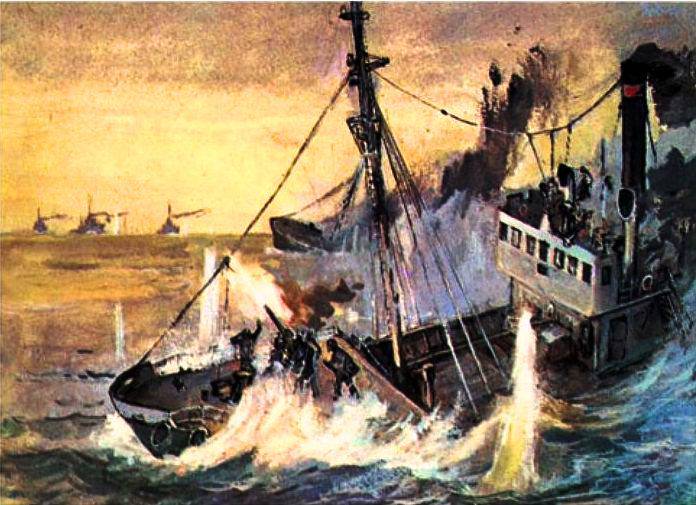
The patrol ship "Passat" on the night of July 13 1941, escorted two rescue ships. The transition began in foggy and rainy weather, but a day later it became clear, and three German destroyers unexpectedly emerged at the intersection of the course of the Soviet ships. Having found the enemy, the commander of the “Passat”, senior lieutenant V.L. Okunevich, gave the order to the escorted ships to go to the shore to take refuge in the bay of Gavrilovskaya, radioed the enemy ships and rushed towards the fascists. Two sorokapyatki, that's all the armament of the "Passat" against destroyers guns. However, the patrol sailors entered into an unequal battle, seeking to divert attention from rescue ships. One ship was already seriously damaged, but the “Passat” with its fire and smoke screen made it possible to lower the boats and escape the crew (more than 70 people). The second vessel managed to escape without loss. But the Passat itself fell under concentrated fire. He was defeated and plunged into the water, but the stern gun continued to operate. It fired at the enemy the last surviving sailor. Such was the feat of this small ship.
"Passat" refers to the patrol ships of the type "RT". These plain-looking ships, built on the basis of ordinary fishing trawlers and having, as a rule, a team of former fishermen, turned out to be truly invaluable unskilled laborers of the war. They were not as impressive and solid as the battleships and cruisers, they did not carry in themselves the grace and swiftness of destroyers, but their contribution to the Victory and the overall heroism of the crews is difficult to overestimate.
In the years of the prewar five-year plans, quite a powerful trawl fleet was created to extract fish in the White and Barents Seas, which on the eve of World War II consisted of 86 sea trawlers. These were mostly steam two-masted vessels with steel hulls, specially designed to operate in the harsh conditions of the Arctic. They had a transverse set system, one deck, a superstructure in the aft part and a forecastle. The total displacement was 1100-1200 t, the length of the 51 meter, and the draft and the height of the freeboard was approximately at 4,5 m. Steam four-cylinder machine with a capacity of 650 l. with. provided the ship with a speed of 9,5-11 knots, which fell sharply during a heavy storm. The longest cruising range was up to 4000-4300 miles, 40-50 autonomy days. The team numbered 40 people. There were two boats. The special equipment and premises included a steam trawl winch with 8-10 tonnes, trawls, a cargo boom, a hold for receiving 400 tonnes of fish, installations for processing fish waste into flour and obtaining fish oil. The trawlers were relatively well provided with radio communication and navigational instruments, some of them also had radio direction finders.
The war caught the fishing fleet behind routine peace affairs in various areas of the Northern Basin. Within two days, all trawlers arrived in Murmansk and Arkhangelsk. In the very first weeks, some of them were converted into minesweepers and patrol ships to replenish the connection of the protection of the Northern water area fleet.
The expansion of the area of military operations and the need to ensure the escort of transports demanded the formation of the White Sea military flotilla. Its combat core consisted of ships converted from trawlers. On 30 September 1941, the White Sea military flotilla consisted of 33 such vessels, or 75% of the total number of large ships. In total, the Northern Fleet from the total number of patrol ships and minesweepers (54 units) to the beginning of 1942 of the year counted 47 ships of this type that received the cipher "RT".
The ships were reequipped mainly at the Murmansk Ship Repair Plant and the Krasnaya Kuznitsa Arkhangelsk Plant. These works, which took two to three weeks to complete, were accompanied, as a rule, by urgent repair of mechanisms, since most of the trawlers were operated for several years without being docked. At the same time, ships were manned by personnel, a significant number of which were fishermen.
In the course of re-equipment on trawlers, some of the special devices were removed (arrows, trawling arches, etc.), the mounting of decks of the forecastle and canopy was intensified, tools, machine guns, and trawls were installed. To increase the firing angle of the stern gun, the boats and davits were transferred from the canopy to the main deck. The bow of the fish hold was retracted under the artillery grab, fenders of the first shots were provided near the guns, nests were built for depth charges, smoke bombs and trawling buoys, trawl trawls were built on both sides in the area of the trawl winch; for foremen and sailors were equipped with fenders. To a large extent, the capitals' bridges and navigation cuts were equipped: negotiation tubes for nose and stern guns were carried out, range finders were installed, replaced with more powerful ship searchlights. The artillery armament on the converted guard ships consisted mainly of two 76-mm cannons and two Maxim machine guns, and on the minesweepers - of two K-34 guns and two machine guns. However, due to the lack of new guns on the six ships of the White Sea military flotilla, old 45-mm cannons of the Kane and Lander systems had to be installed with an elevation angle of 21 °, which could not fire on high-flying aircraft.
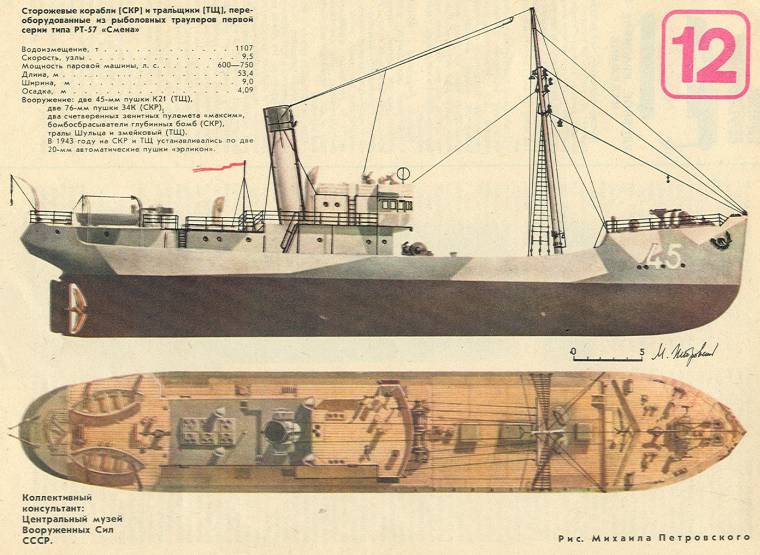
Some patrol ships of the main fleet base (for example, Passat, Fog) were armed only with 45-mm guns. “RT” type minesweepers were armed with Schulz contact sea trawls and snake trawls. Armament during the war was constantly improved. In the spring of 1942, many minesweepers of the RT type were installed by low-speed guards from TOK-1 mines, some sentry ships received bomb-bombs, and seven minesweepers were acoustic trawls. The artillery and anti-mine armament of the ships by the summer of 1943 was especially strengthened. Thus, on ten minesweepers and seven patrol ships of the “RT” type, two additional 20-mm Oerlikon automatic cannons were installed, sixteen minesweepers received more advanced Oropesa contact trawls, and nine Congo trawls; on some ships, they increased machine-gun armament, updated radio communications equipment. In March, two minesweepers (TCH-1944 and TCH-61) supplied 64 with electromagnetic trawls.
Converted ships took an active part in hostilities: guarded transport vessels at crossings, carried patrol service, engaged in trawling, and the delivery of military cargo and personnel. In the area of the main base of the Northern Fleet, there were about 20 former trawlers that were part of the patrol ship division and the division of marine minesweepers for the protection of the water area. The fighting in the Kola Bay took place in the face of vigorous Nazi aviation and submarines. Repeatedly, ships of the "RT" type had to act against superior enemy forces. The heroic exploits of the crews of the Passat patrol ships (former Chkalov) and Tuman (former Winch), which entered into an unequal battle with enemy destroyers in 1941, are widely known. A lot of difficult trials fell on the personnel of the RT type ships, which fought with the enemy as part of the White Sea naval flotilla. In the navigation of 1941, 1942, 1943, they bore the main burden of protecting internal convoys and maintaining sentinel services in the White Sea and the Arctic.
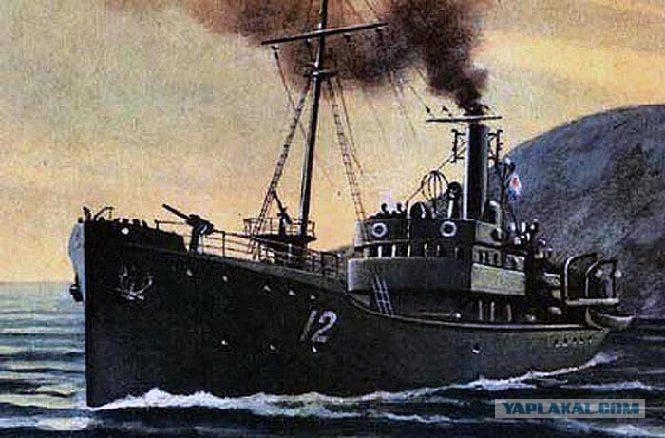
The experience of using ships converted from trawlers in the North during the Great Patriotic War allows us to evaluate their combat capabilities. Regardless of class, they were intended mainly for escort purposes. Suffice it to say that in the White Sea military flotilla, the 58 ships spent time at sea for escorting transport ships, 22% for sentinel services, and only 11% for trawling, although minesweepers accounted for most of the converted trawlers, 9% was occupied by combat training . This was due primarily to the need to guard a large number of caravans in the arctic regions, on 400-1000 communications and more miles. It is known that during the war years, the 1470 internal and 77 allied convoys passed in the zone of the Northern Fleet, resulting in a total of more than 4030 transports.
Good seaworthiness and durable hulls allowed ships of the “RT” type to perform combat missions in conditions of strong sea and ice conditions. Thus, despite the 77-point storm, TFR-12, for three days in September, 1942 was on the watch line of the Cape Holy Nose - Cape Kanin Nos. “TFR-74” with freezing and snow charges in the 10-point storm fulfilled the 28 of October 1942, the difficult task of removing stones and towing the Roshal steamer off the coast of New Earth. During the period of winter navigation 1943-1945. “RT” type ships were successfully used on the White Sea as an “intermediate escort” at the edge of the ice during the transfer of Allied transports from destroyers to icebreakers and back. The main disadvantage of the ships of the type "RT" was that in speed they were significantly inferior to the vehicles protected by them (8-10 versus 12-14 knots.).
The trawlers showed themselves relatively well in repelling the attacks of enemy aircraft. Despite the lack of anti-aircraft weapons in the early years of the war and much less room for maneuver as compared to special-purpose warships, the converted ships on the high seas repeatedly fought off enemy aircraft. Applying a maneuver of evasion and firing from guns and machine guns, even such low-speed ships could repel the attacks of enemy fighters and bombers.
More dangerous for ships of the type "RT", devoid of sonar equipment, were fascist submarines. Having the ability to act covertly, they also exceeded the trawlers in speed and artillery caliber (88-mm guns against 76- and 45-mm). In the most difficult situation were escorts guarded by ships of the “RT” type in a collision with submarines away from bases, when timely support by aircraft or high-speed anti-submarine ships was impossible. So, the convoy "BA-18" consisting of four transports and five escort ships (minelayer "Murman", minesweepers "TSH-31", "TSHCH-63", "TSHCH-40", "TSHCH-42") October 1 1943 of the year around the islands of the Arctic Institute had to repel multiple attacks of three fascist submarines of the Viking group. Taking advantage of the speed, the boats easily walked away from pursuit and again took up positions to attack. Despite the courage of Soviet sailors, the convoy lost two transport and "TSC-42".
Former trawlers "SKR-25", "TSCH-39", "TSCH-57", "TSCH-58", "TSCH-55", "TSCH-64" and other ships during the war years entered into artillery combat with enemy submarines boats, forcing them to move to a submerged position. The fascist artillery duel failed even when meeting with the armed trawler RT-89 22 in October 1944 north of Cape Holy Nose.
As minesweepers, ships of the “RT” type were used during the war mainly for controlling trawling of installed fairways from Arkhangelsk to Murmansk and Novaya Zemlya and only to a small extent for continuous trawling of obstacles from anchor mines in the White Sea and at Pechenga. With trawls delivered, they traveled more than 59 thousand miles. The trawling was most difficult in winter conditions, at the Cape Ostryi Ludki in the White Sea, when “TSHK-60” destroyed a serpentine trawl for several minutes. The trawling of non-contact landmines ships of the “RT” type were rarely involved. Here is one of the few examples: in October 1942 of the year “TSCH-32” under the command of Senior Lieutenant I.I. Dugladze, together with three British minesweepers, participated in the destruction of enemy acoustic mines in the Yugorsky Ball. It should be noted that the crew of this ship repeatedly differed in the performance of other tasks of the command, for which, by Decree of the Presidium of the Supreme Soviet of the USSR, 31 was awarded the Order of the Red Banner by May 1943.
In the White Sea and the southeastern part of the Barents Sea, the main danger during the 1941-1943 period was represented by mines torn from anchors. They were destroyed from guns, as a rule, along the way, but when a large number of mines were found, it was necessary to use ships or coastal parties on purpose. The minesweepers TSCH-46 and TSCH-47, in the period from 12 to 19 in October 1941 of the year, destroyed around 40 floating mines in the Mezen gulf. And from June 15 to 8 July 1943, the ships of the “RT” type destroyed at the rate of convoys from Cape Kanin Nos to the Kara Gate 25 mines.
The experience of the combat use of re-equipped trawlers showed that with strong hulls, the power of the main machines was insufficient, this did not provide the necessary speeds when evading torpedoes and bombs, when attacking submarines and mines sweeping with new trawls; lack of steering wheel area made it difficult to maneuver. The lack of aft artillery cellar caused a great inconvenience, therefore, in battle, to feed the shells to the stern guns, a large number of people had to be attracted. The durability of auxiliary mechanisms and devices was not ensured, due to the fact that they, as a rule, were powered from one steam line. The survivability of the ships was reduced due to the lack of longitudinal bulkheads in water tanks, which also made it impossible to align the roll of the ship. Disastrous for ships of the type "RT", who did not have a sufficient number of watertight bulkheads, turned out to be undermined by mines or hit by torpedoes. The 250-kilogram bomb bombs at a distance of 5-10 m, as a rule, did not damage the hulls of the ships, there were no breaks in the seams and pop-up rivets, however, the cast-iron parts (cabinets of telegraphs, dynamo brackets) broke down, the radio equipment broke down , flew out of the nests magnetic compasses. The most serious damage occurred when the bombs pierced the ship and exploded near the bottom.
Despite all this, ships of the Northern Trawl Fleet, along with other ships and boats converted from civilian ships, played a large role in the Great Patriotic War, especially in its first, most difficult period, when the Northern Fleet experienced an acute shortage of naval personnel.
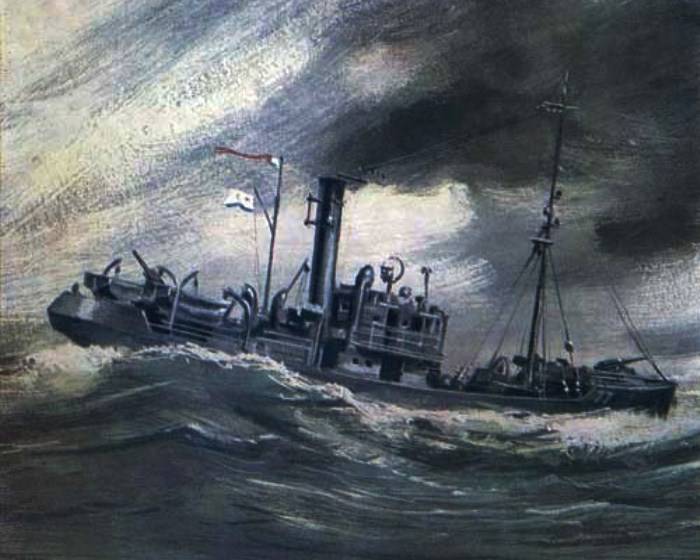
Converted ships, many of which died during the performance of combat missions, made it possible for the command to gain time needed to replenish the Northern Fleet with special-purpose warships, which in 1944 took the main burden in escorting numerous convoys. Best of all, “RT” showed itself in patrols - as messengers of ships and escort ships in conditions of rarefied or young ice, where the use of high-speed warships was impossible or irrational. And armed with “airlikons” of the RT, they also performed the tasks of air defense well.
Sources:
Kobchikov E. Yu. The Fight and the Death of the Fog Patrol Ship // Gangut. 1993. No.6. C. 26-34.
Kozlov I., Shlomin V. Red Banner Northern Fleet. M .: Voenizdat, 1977. C. 126-128, 267-269.
Weiner B. The Northern Fleet in the Great Patriotic War. M. Voenizdat, 1964. C. 296, 297.
Puzyrev P. Re-equipment of trawlers into warships of the Northern Fleet // Shipbuilding. 1985. No.5. C. 56-58.
Kiselev A., Krasnobaev A. History Murmansk Trawl Fleet. Murmansk: Murmansk Book Publishing House, 1973. C. 100-104.
Shitarev V. Workers and Warriors // Technique of Youth. 1985. No.12. C.20-21.
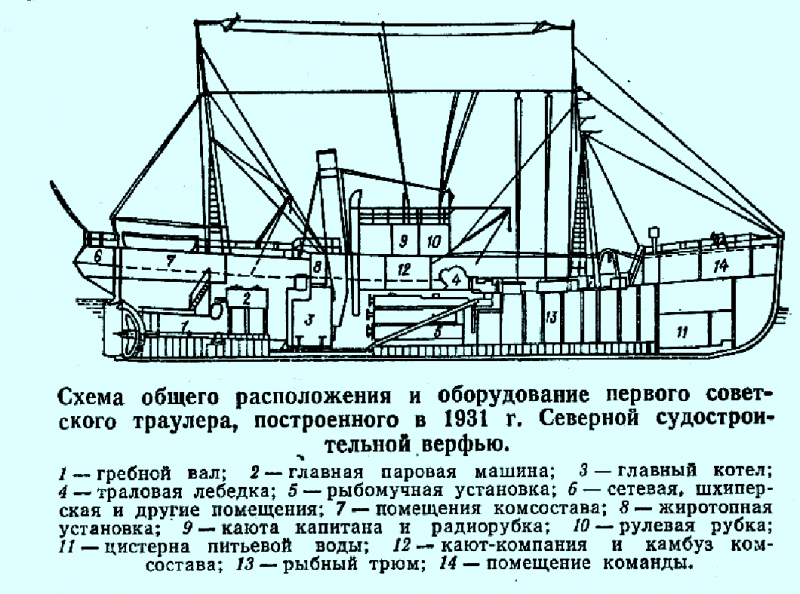
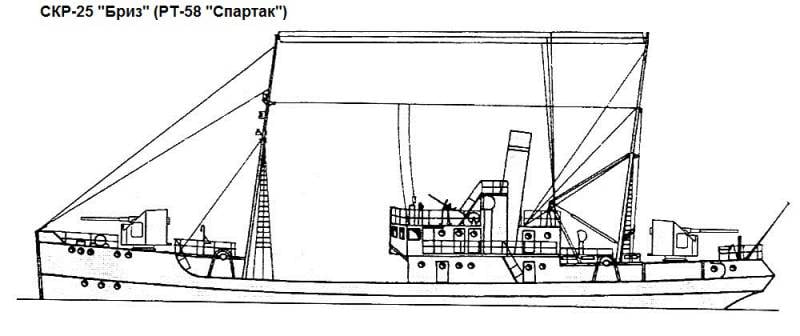
Information